Famous Mineral Localities
The Pegmatites of Laghman, Nuristan, Afghanistan
by
| Pierre Bariand La Fusade 24250 Donne France Tel: 33-5-5328-3749 |
J.F. Poullen |
![]() Biography of Dr. Pierre Bariand
Biography of Dr. Pierre Bariand
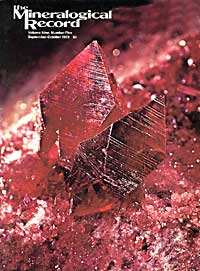 |
Editor’s Note: We are pleased to reprint this selection from the Mineralogical Record, September–October 1978, pp. 301–308. Click on the above link for subscription information to America’s finest mineral magazine. We would like to thank Pierre Bariand and Wendell Wilson for permission to reprint this important article.
Many gem crystals of spodumene, tourmaline and beryl have been extracted during the past few years from the pegmatite fields in eastern Afghanistan. In the region of Nuristan, the pegmatites appear to occur over a considerable area. In certain of these localities specimens of quite exceptional color and perfection have been found, easily rivaling those discovered in the other great worldwide deposits.
INTRODUCTION
Until recently, Afghanistan was principally renowned in the world of the mineralogists and gemologists for the famous deposits of lapis lazuli in the Badakhshan (a province in the northeastern part of the country, separated structurally from Nuristan by the Pandjshir fault) and also, in lesser measure, for the rubies in the Jegdalek marble near Sorobi. More recently, emeralds from Pandjshir valley and the pegmatitic minerals of Nuristan have appeared on the market (the exploitation of these was made possible by Russian Geologists who found the deposit in 1970).
However, in actuality the gems of Nuristan were discovered long ago, because during the archeological diggings done in the ruins of the ancient Greek town of Ay-Khanoum (Badakhshan), situated at the confluence of the Amou-Daria and Koktcha Rivers, some treasures were exhumed which contained, in addition to many fragments of lapis-lazuli, perfect crystals and gems of beryl which must have come from the high valleys of nearby Nuristan.
Even though Nuristan is geologically one distinct structural unit, essentially crystalline and limited on the south by the Quaternary basin of Jalalabad, it is administratively divided into two provinces: Laghman to the west, and Kunar to the east, bordering the Pakistani province of Chitral. The pegmatites of Kunar supply splendid crystals, especially of beryl, as in the celebrated deposit of Gur-Salak, and also of tourmaline and kunzite in the Kantiwa field. However, the best pieces seem to have been found in Laghman, and that is why in the main part of this article we limit ourselves to that province.
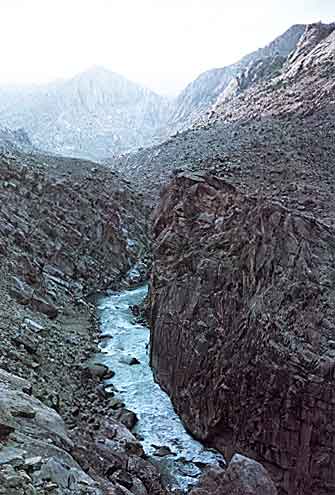 |
| Figure 1. Alingar Canyon near Nuristan, Afghanistan |
GEOLOGY
The three deposits that we were allowed to visit (Nilaw, Mawi, and Kurgal) are situated not far from the most important river in Laghman, the Alingar, which rises in the far north of the province and joins the Kaboul [Kabul] River in the south a few kilometers from Mehtar Lam.
The rock types are quite varied but always metamorphic or intrusive. They are mostly gneisses (complex migmatites), mica schists, quartzites and marble (which undoubtedly correspond to the original lithostratigraphic formations later metamorphosed), with diverse intrusions of granites (with biotite, amphibole or two micas) and of more mafic rocks such as diorite and gabbro. The metamorphism, which is imposed on an old sedimentary series, is weak in places; cross-bedding and graded bedding are still visible and the contact between the weakly metamorphosed series and the migmatites is relatively sharp.
The pegmatites, those of Nilaw and Mawi especially, occur as veins of highly variable size, from 10 cm to 40 meters in thickness and from a few meters to a few kilometers in length, in what has been called the plutonic intrusion of Nilaw (Fuchs et al., 1974), which is composed of rocks ranging from diontes to gabbros, and which shows conspicuously in the broader migmatitic complex. The intrusion is rich in layers of marble with calcium silicates.
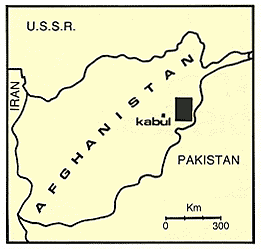 |
| Figure 2. Locality of the map area shown in Figure 3. |
The vein network of pegmatites is more dense toward the southern end of the intrusion, especially at the points where it touches tourmaline-two-micas granite which is localized to the southeast. This granite seems to be the source of the pegmatite veins injected into the dioritic intrusion, since toward the west, in contact with the biotiteamphibole granite, the vein cluster is thinner and more sparse, and is replaced by breaks of the alpine cleft type containing adularia, chlorite, epidote and axinite.
The pegmatite veins in the Nilaw intrusion have a very characteristic, stratiform shape which may be described as “watch glass,” horizontal in the center of the pluton and plunging slightly at the edges. This “ring dike” aspect can be explained as the sinking of segments around the edges of the roof of the subjacent reservoir. The products coming from the two-mica granite could then be injected into the empty spaces thus created. But it is possible to imagine other causes (form of the isotherms, reduction of volume of the diorite on cooling lateral compression, etc.).
In a more general way, the tectonic directions of the metamorphic rocks are consistently NNE-SSW, and the series of intrusions follows that orientation even though indiscriminately cutting all of the enclosing metamorphic formations. According to Fuchs et al. ( 1974) the geologic history of that region should be as follows:
A Paleozoic sedimentary series, deposited on a basement of migmatites, was subjected to metamorphism and then to intrusion by various rock types (diorites, gabbros, and finally biotite-amphibole granites) leading to the remobilization of the migmatites. Fuchs et al. (1974) supposed that the intrusions appeared during the alpine cycle (the diorites may be of lower Cretaceous age and some of the granites of Oligocene age). The pegmatites in the pluton of Nilaw appeared later.
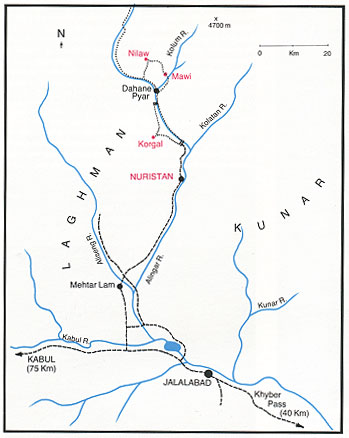 |
| Figure 3. Location of towns and deposits in the Laghman-Kunar area. |
THE DEPOSITS
Even today the deposits of Laghman are difficult to reach due to the considerable distances that must be covered on foot. Neither mules nor horses can be obtained, which considerably limits the number of points accessible to a visitor.
At present, the end of the jeepable road is situated very far below the interesting sites. In 1977, this road, which leaves the Kabul–Jalalabad route, goes straight northward to Mehtar Lam and ends several kilometers beyond the village of Nuristan (70 km after the fork) just at the point where a small, recently constructed bridge (Gandalabouk) crosses the Alingar River. Then a full day on foot is needed to traverse the 25 km of narrow gorges which separate that bridge from the nearest houses (5 houses, one belongs to the subgovernor) one hour away from the village of Dahaneh-Pyar, at the junction of the Kolum and Alingar rivers. Yet another full day is necessary to reach the deposit of Nilaw – 15 km of bad rocky trail.
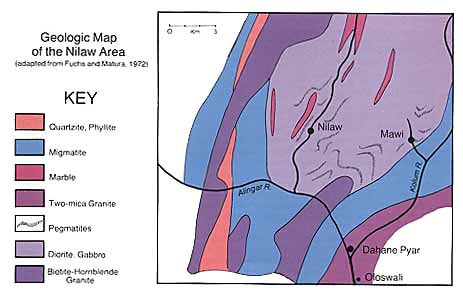 |
| Figure 4. Geologic map of the Nilaw area. |
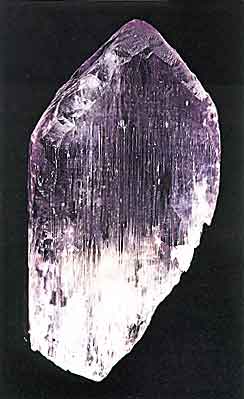 |
| Figure 5. Kunzite spodumene, 20 cm tall, from Mawi, Laghman, Afghanistan (collection of the Sorbonne). Photo by Nelly Bariand. |
Nilaw
The stratiform pegmatite vein can be easily seen even from far away, forming white bands that show clearly in the abundant vegetation of the little narrow valley of Nilaw. In several places the pegmatites have been exploited with the use of dynamite.
Afghan law prohibits anyone from exploiting deposits of any kind whatever, excepting the employees of the Ministry of Mines, who work periodically on the most interesting zones. That prohibition even applies to the local village inhabitants; but this does not stop the smugglers who come, from Kabul and elsewhere, well prepared to make a fortune by selling the products of their work in the markets, especially in Kabul, Peshawar, Gilgit and even Tucson. The beryllium and lithium pegmatites of central Laghman are now prospected only for gems, and not for industrial elements such as Be, Li, Nb-Ta or Cs. In the Kunar field, beryllium is the only industrial element being exploited.
The extent of the pegmatite veins of the zone called Kolum (Nilaw-Mawi) seems to be associated with the nature of the enclosure. In the Proterozoic formations they rarely reach 100 m in length and do not exceed 10 m in width, while in the gabbro-dioritic intrusions they can be followed for several kilometers (up to 7 km for some veins) and certain local enlargements have a thickness of 50 m.
According to Rossovskij et al. ( 1974) it is possible to define several types of pegmatitic veins from their mineralogic composition:
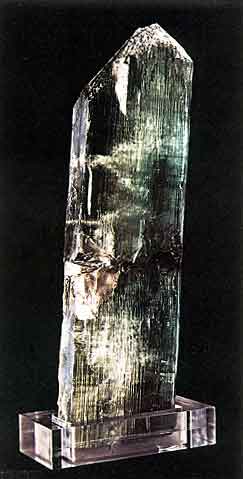 |
| Figure 6. Green spodumene crystal 60 cm tall. This is probably the finest crystal yet recovered. It is twinned and doubly terminated. From Mawi, Laghman, Afghanistan (collection of the Sorbonne). Photo by Nelly Bariand. |
- Oligoclase-microcline with black tourmaline and beryl.
- Albitized microcline with more frequent black tourmaline and beryl.
- Albitized microcline with black tourmaline, beryl and concentrations of lepidolite, multicolored tourmaline, spodumene, and pollucite.
- Albite with segregations of lepidolite and spodumene.
- Lepidolite, spodumene and albite.
Three types of veins (2, 3 and 5) are found in the Nilaw field. The central part of the third type of vein shows lepidolite, blue cleavelandite, multicolored tourmaline, kunzite (lilac-colored spodumene), white-pink spodumene, beryl and pollucite. Microlite, manganotantalite, columbite-tantalite and cassiterite are present there and also in type 5. Fuchs et al. (1974) advance the figure of 1,000 tons of reserve of beryl in the veins where it is exploitable in segregations. The average contents of Li, Cs, Rb and Sn are also appreciable (Rossovskij et al., 1974; Chmyriov et al.. 1975).
The workings that we visited cut the pegmatites only in a place where the thickness of the vein is about 15 m. The zonation of this body is asymmetrical; fine grained in the lower levels, and in higher levels an assemblage of large size crystals, where quartz, microcline and spodumene dominate. The crystals of spodumene embedded in the rock are rosy and opaque, in immense sheafs with rather diffuse outlines. Crystal-lined cavities are mostly localized toward the top of the vein; those that we could examine are about 50 cm across and contain essentially large crystals of quartz and microcline. It is certain that they also contained crystals of kunzite as we saw elsewhere. Muscovite, black tourmaline and beryl are found in the matrix, as are also some phosphates of iron, manganese and lithium. At the top, limited to a layer 20 cm in thickness, the pegmatite is full of blades of columbite-tantalite. We have also noticed that the pegmatites at Nilaw, as at Mawi and Korgal, are invariably associated with amphibolites.
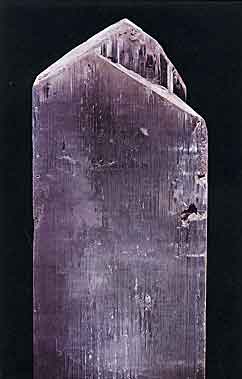 |
| Figure 7. Kunzite crystal, twinned, 15 cm tall, from Mawi, Laghman, Afghanistan (collection of the Sorbonne). Photo by Nelly Bariand. |
Mawi
East of Nilaw, not far from the Kolum River, is the famous deposit of Mawi where very large crystals of spodumene (green, blue, pink, yellow and colorless), beryl (morganite and aquamarine) and tricolored tourmaline were discovered. The path from Nilaw to Mawi is relatively easy and can be covered in a half-day walk. It is necessary to cross the Koh-e-Sagoli range (altitude about 3,000 m), then descend again through the short valley of Mawi until the dumps that mark the zones of exploitation appear. It is difficult to judge the thickness of the Mawi pegmatites, but it is surely considerable. (According to Rossovskij, et al. [1976], the principal vein is about 40 m thick and runs for 1,200 m.) The following paragenesis can be recognized:
- Aggregates of quartz and muscovite of about 10 cm thickness first formed at the borders of the veins, in contact with the wall rocks, some with blue-green beryl crystals of large size.
- Biotite and microcline with quartz, aquamarine, and black tourmaline formed next. This association is only observable in the eastern part of the deposit.
- A discontinuous zone of giant crystals of quartz and microcline then formed. The beryl crystals are found only in the apophyses of the principal vein.
- Then a “zone” of quartz and spodumene formed, which actually comprises local segregations with a thickness of several meters, also containing crystals of columbite-tantalite. The spodumene crystals of this “zone” are of great size (up to 2 m long)
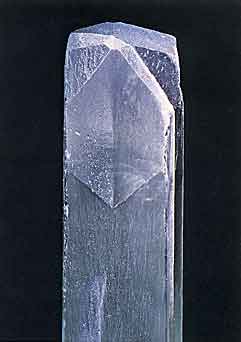 |
| Figure 8. Spodumene crystal, twinned and showing re-entrant angle, from Mawi, Laghman, Afghanistan (collection of the Sorbonne). Photo by Nelly Bariand. |
Paragenetic stages 5 through 7 proposed by Rossovskij et al. consist of the associations albite-muscovite-quartz in various proportions, in places sugary, with concentrations of lepidolite, multicolored tourmaline and spodumene. The latter mineral seems the most sought after at Mawi. In July of 1973, 420 kg of spodumene were extracted there, and 176 kg in October-November of the same year. These figures lead one to suppose that the reserves are important. Estimates of reserves of beryl immediately exploitable at Mawi lead to a total in the vicinity of 50 tons. Tantalite and pollucite seem too dispersed to be of economic value.
On visiting several dumps, we were able to observe great plates of rock, covered with crystals of quartz, microcline and albite (cleavelandite), on which had been fixed the crystals of spodumene of which only the bases remain, individual crystals having been detached from their support by the gem hunters. However, spodumene lining cavities seemed rare and the production consists largely of isolated, free crystals that are extracted from pockets in altered pegmatite. The same appears to be true for beryl. We also found several specimens covered with little crystals of tricolored tourmaline and even colorless tourmaline (achroite). It is, however, illusory to imagine gathering beautiful crystals if one has only a geologist’s hammer. Other minerals also caught our attention, notably some pretty spessartine garnets embedded in the pegmatite and also two enormous balls of botryoidal muscovite with a maximum diameter of 30 cm but, sadly, untransportable.
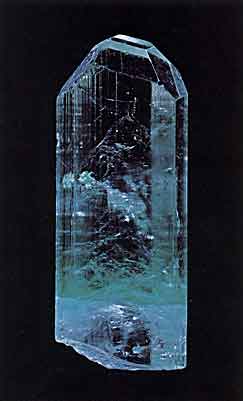 |
| Figure 9. Elbaite tourmaline crystal 4 cm tall from Mawi, Laghman, Afghanistan (collection of the Sorbonne). Photo by Nelly Bariand. |
Korgal
The deposit of Korgal is famous for its extraordinary, absolutely transparent green tourmaline, so sought after by the gems hunters. The mine is situated in a little valley on the other side of the Alingar River. From Dahaneh-Pyar, two ways of access are possible. The longer (a one and one-half day hike) consists of going back down the Alingar to the bridge, crossing the river at that point and searching for the path which takes off upstream in the direction of Dahaneh-Pyar. The second way is more dangerous but takes only a half day: at Oloswali, cross the Alingar River over the small bridge at the exit of the village, then go down the river along the slope to Korgal. Unhappily, this path is very often cut by rock cliffs that have to be jumped over, not without some acrobatics.
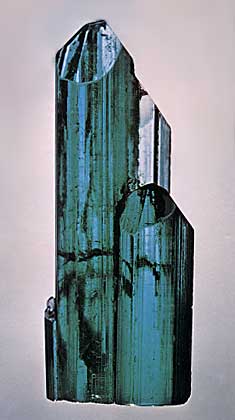 |
Figure 10. Elbaite tourmaline crystal 6 cm tall from Korgal, Laghman, Afghanistan (collection of the Sorbonne). Photo by Nelly Bariand. |
The deposit consists of several veins of pegmatite embedded in crystalline schists and garnet-sillimanite-biotite gneiss, all Proterozoic. The thickness of the veins is from I to 50 m, over a length of several hundred meters. Four typical mineral associations have been observed by Rossovskij et al.:
- Microcline-muscovite-black tourmaline granitic pegmatite, with sporadic manganotantalite and pollucite.
- Oligoclase-microcline-blacktourmaline-muscovite-beryl.
- Oligoclase-microcline-black tourmaline-muscovite with segregations of lepidolite and multicolored tourmaline.
- Albitized pegmatite with microcline.
The pegmatite contains an abundance of gem crystals of tourmaline (green and sometimes pink), in places forming magnificent sheaves on muscovite. Spodumene and beryl seem less common. At Korgal, as in the other deposits, the phosphates triplite, purpurite and heterosite are rare, although eosphorite has been found. Clear, gemmy bastnaesite crystals, that we have heard about must come from the emerald mines of Pandjshir valley where some contact hydrothermal processes have affected the carbonate formation.
 |
| Figure 11. Elbaite tourmaline crystal 6 cm long from Korgal, Laghman, Afghanistan (collection of the Sorbonne). Photo by Nelly Bariand. |
MINERALS
The minerals that we have observed are very typical of pegmatites rich in Be and Li: quartz, microcline, albite, lithium-tourmalines, pink and blue beryl, spodumene, muscovite, lepidolite, triplite, heterosite, purpurite, manganotantalite, columbite-tantalite, cassiterite, spessartine, violet apatite and pollucite. Under present conditions, it is only the gem minerals (tourmaline, spodumene and beryl) that make these deposits interesting.
Tourmaline is the most remarkable mineral. It is present in an astonishing variety of forms and colors. Great pink crystals with flat terminations with many striations, sprinkled with lepidolite, very much resembling those from Pala, California, have probably been extracted in the region of Korgal. At the home of a merchant in Kabul we noticed one section of such a crystal that was 30 cm in diameter. The small, tricolored crystals (pink base, green center, colorless top) seem more characteristic of Mawi. The yellow-brown tourmaline crystals seen in the bazaar in Kabul are of unknown provenance (probably Kantiwa field) as well as the crystals of deep blue color. The crystals of green, and especially the most valued shades of blue, green and emerald green, come from Korgal. Multicolored crystals grade smoothly from one color to the next. The terminations of the little crystals are in sharp pyramids due to the predominance of the faces {0221} which are progressively supplanted in the course of mineral growth, by the faces {1011}by elimination of the forms which have a greater rate of growth. The large crystals, which can reach 2 by 15 cm and perfectly transparent, are terminated by the low-angle pyramid {1011}.
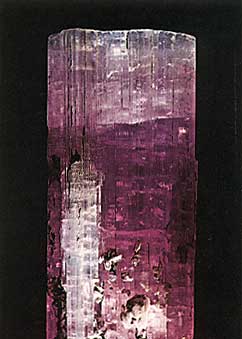 |
Figure 12. Elbaite tourmaline crystal 6 cm wide from Mawi, Laghman, Afghanistan (collection of the Sorbonne). Photo by Nelly Bariand. |
| Figure 13. Elbaite tourmaline, 21 by 15 cm, from Laghman, Afghanistan (Herb Obodda collection). Photo by Wendell E. Wilson. | 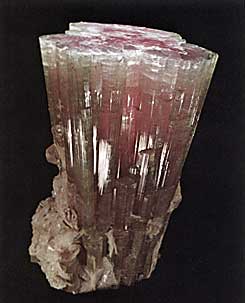 |
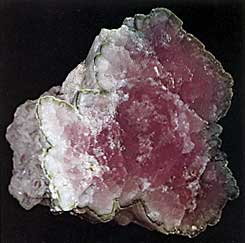 |
Figure 14. Top view of crystal shown in Figure 13. Photo by Wendell E. Wilson. |
Beryl is especially abundant in the Kunar area, but the gem varieties, aquamarine and morganite, are found mainly in the Laghman district, where they occur with the basal pinacoid characteristically well developed. Loose crystals and crystals on matrix have been recovered. The tint varies from pink to brownish pink. Gem aquamarine crystals of a beautiful, intense blue have shown up, but it is possible that this discovery was made at Gur-Salak in Kunar.
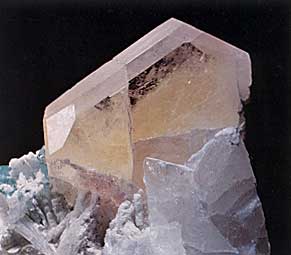 |
| Figure 15. Morganite beryl crystal 6 cm across on matrix with tourmaline, quartz and albite, from near Nuristan, Afghanistan (Herb Obodda collection). Photo by Wendell E. Wilson. |
Spodumene from Laghman has also acquired a just fame. This region has produced some gem crystals of astonishing size (up to a meter long). The diversity of colors, purples, pinks and greens, is almost indescribable. One even finds bicolored crystals, though a true hiddenite has not yet been reported. The shape is, in general, classic: elongated clinoprisms flattened parallel to the striated {100} face. However, certain of these prisms are limited laterally by {010}on one side, and by the face {110} (parallel to cleavage) on the other side, in such a way that it appears to be a crystal broken along the plane of cleavage. This is an error and it is easy to check by observing the corrosion figures on the {110} face which can also be a crystal face. Several individuals reveal a roughly square section, in consequence of the equal development of the {010} and {100} forms. We have also brought back a crystal, remarkable by the abundance of lateral faces, which clearly shows the twin on {100}, having a characteristic re-entrant angle between the two individuals that we have never before seen.
Unlike the large spodumene crystals from pegmatites in California and in Minas Gerais, Brazil, Laghman spodumene crystals have remarkably flat and well-developed faces and relatively sharp, rather than rounded, edges.
The other interesting peculiarity of Laghman spodumene is its occurrence in cavities or pockets of crystals, for example one superb specimen that we could only admire: a large crystal of microcline (20 kg) on which a 15-cm crystal of transparent pink spodumene was attached. We also found parallel groups of crystals composed of two or three individuals. Crystals of spodumene with attached crystals of tourmaline are also known.
Just as for tourmaline, the spodumene is used in jewelry and sold at a price per carat. However, gem spodumene is less valued than tourmaline because it sometimes fades in the light and has a tendency to cleave easily while being cut.
EDITOR’S NOTE [from 1978]
The government of Afghanistan was overthrown in April. 1978, by a leftist revolutionary group, casting some doubt on the future accessibility of Afghan minerals to foreigners. Although the new government is clearly more radical than its predecessor, American State Department officials familiar with the area say it is far from certain that Afghanistan will become a Soviet satellite. The new government party was reportedly not accepted as a communist party by Moscow. Accounts of the April 27 upheaval obtained by U.S. officials indicate the Soviet Union had no part in preparing or executing the coup. The assessment in Washington is that the new government will lean more toward the Soviets than the previous regime; however, Afghanistan has historically had close relations with its Russian neighbor while nevertheless placing a high value on its own independence. Officials of the coup have spoken of a “positive neutrality” in foreign affairs, with relations to other countries determined by the extent of their political and economic support. The officials said that Afghanistan will not accept aid with strings from any nation. Moscow immediately recognized the new government and has offered about $16 million in civil aid. The United States has also recognized the new regime and offered to continue economic aid which has been about $20 million annually in the past. Most of the 60 advisors from the United States in Afghanistan at the time of the coup are expected to remain, and West Germans have been asked to stay on as police advisors (Oberdorfer, 1978). There is, therefore, reason for cautious optimism that exports of mineral specimens and gems might be able to continue.
ACKNOWLEDGMENTS
We wish to thank Allen Bassett for providing the English translation of this article.
REFERENCES
FUCHS, G., MATURA, A., and SCHERMAN, O. (1974) Verbericht über geologische und Lagerstättenkundliche Untersuchungen in Nurestan, Afghanistan. Verhanglungen Geologische Bundesaust., (Osterreich), no. 1, 9–23.
OBERDORFER, D. (1978) Activity in Afghanistan stirs concem. The Washington Post, May 29, 1978, p. A12.
ROSSOVSKIJ, L. N. CHMYREV, V. M., and SALAKH, A. S. (1976) Aphanitic dikes with spodumene among lithium pegmatites; conditions of formation. Doklady Akademia Nauk SSSR, 226, no. 6, 1418–1421.
![]()
 |
About the author. Dr. Pierre Bariand was curator of the mineral collection at the Sorbonne from 1956–1998. He is now retired. Since 1959, he has made significant contributions to the field, especially with new minerals he discovered from Iran where, for many years, he served as mineralogical expert and advisor. Dr. Bariand’s wife, Nelly, is a remarkable photographer and film-maker.